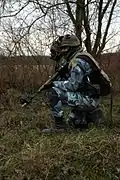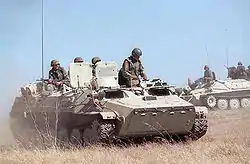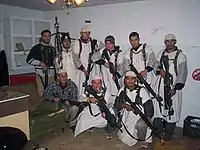An opposing force (alternatively enemy force, abbreviated OPFOR or OpFor) is a military unit tasked with representing an enemy, usually for training purposes in war game scenarios. The related concept of aggressor squadron is used by some air forces. The United States maintains the Fort Irwin National Training Center with the 11th Armored Cavalry Regiment serving in the OPFOR role. Fort Johnson's (formerly Fort Polk) Joint Readiness Training Center (JRTC) is another major training site typically reserved for light infantry units, and the OPFOR are the 1st of the 509th Airborne Infantry Regiment. The Army's Joint Maneuver Readiness Center (JMRC, at Hohenfels, Bavaria, Germany) has the 1st of the 4th Infantry Regiment as their OPFOR. Other major units include the First United States Army which consists of 16 training brigades that often also serve as OPFOR.
At a basic level, a unit might serve as an opposing force for a single scenario, differing from its 'opponents' only in the objectives it is given. However, major armies commonly maintain specialized groups trained to accurately replicate real-life enemies, to provide a more realistic experience for their training opponents. (To avoid the diplomatic ramifications of naming a real nation as a likely enemy, training scenarios often use fictionalized versions with different names but similar military characteristics to the expected real-world foes.)
Units
China
France
In the French Army, a FORAD (FORce ADverse, enemy force) is used to train the army, in both the centre d'entraînement au combat (CENTAC, Combat Training Center) of Mailly-le-Camp[1] and in the centre d'entraînement aux actions en zone urbaine (CENZUB, Urban Operations Training Centre).[2] Declassed AMX-30 tanks were used to simulate Soviet T-72s,[1] until 2018.[3]
Japan
United States
There are three major training centers that utilize home-based OPFOR units for the US Army:
- The National Training Center or NTC at Fort Irwin, California—home unit is the 11th Armored Cavalry Regiment (the Blackhorse)[4]
- The Joint Readiness Training Center or JRTC at Fort Johnson, Louisiana—home unit is the 1st Battalion, 509th Parachute Infantry Regiment (the Geronimos)[5]
- The Joint Multinational Readiness Center or JMRC (formerly known as the Combat Maneuver Training Center or CMTC) at Hohenfels, Germany[6]—home unit is the 1st Battalion, 4th Infantry Regiment (Separate) (the Warriors)
Various US military installations or major units have their own local versions of opposing force used for training exercises. The joint Australian–US military exercise "Crocodile '03" featured an Australian-led opposing force in which soldiers from a range of Australian units worked together with a US Marine Corps contingent.[7]
Several state defense forces have served as OPFOR units when training with the National Guard. The California State Guard,[8] the Georgia State Defense Force,[9] and the New York Guard[10] have provided OPFOR services to their respective National Guard counterparts. In 2018, the Georgia State Defense Force established the OPFOR Battalion[11] to assist National Guard Soldiers with pre-deployment training.
Ranks
- Officer ranks
| Rank group | General / flag officers | Senior officers | Junior officers | Officer cadet | ||||||||||||||||||||||||||||||||
|---|---|---|---|---|---|---|---|---|---|---|---|---|---|---|---|---|---|---|---|---|---|---|---|---|---|---|---|---|---|---|---|---|---|---|---|---|
(1953–1962)[12] |
.svg.png.webp) |
.svg.png.webp) |
.svg.png.webp) |
.svg.png.webp) |
.svg.png.webp) |
.svg.png.webp) |
.svg.png.webp) |
.svg.png.webp) |
.svg.png.webp) |
.svg.png.webp) |
.svg.png.webp) |
|||||||||||||||||||||||||
| Marshal | General of army | General of corps | General of division | General of brigade | Colonel | Commandant | Major | Captain | Lieutenant | Sub-lieutenant | Warrant officer | |||||||||||||||||||||||||
(1962–?)[13] |
||||||||||||||||||||||||||||||||||||
| Marshal | General of army | General of corps | General of division | General of brigade | Colonel | Commandant | Major | Captain | Lieutenant | Sub-lieutenant | Warrant officer | |||||||||||||||||||||||||
| Rank group | General / flag officers | Senior officers | Junior officers | Officer cadet | ||||||||||||||||||||||||||||||||
(1953–1962)[14] |
.svg.png.webp) |
.svg.png.webp) |
.svg.png.webp) |
|||||||||||||||||||||||||||||||||
| Air marshal | General of air | General of air army | General of air corps | General of air division | Colonel | Commandant | Major | Captain | Lieutenant | Sub-lieutenant | Warrant officer | |||||||||||||||||||||||||
(1962–?)[15] |
||||||||||||||||||||||||||||||||||||
| Air marshal | General of air | General of air army | General of air corps | General of air division | Colonel | Commandant | Major | Captain | Lieutenant | Sub-lieutenant | Warrant officer | |||||||||||||||||||||||||
- Other ranks
| Rank group | Senior NCOs | Junior NCOs | Enlisted | |||||||||||||||||||||||||||||||||
|---|---|---|---|---|---|---|---|---|---|---|---|---|---|---|---|---|---|---|---|---|---|---|---|---|---|---|---|---|---|---|---|---|---|---|---|---|
(1953–1962)[16] | .svg.png.webp)
| .svg.png.webp)
| .svg.png.webp)
| .svg.png.webp)
| .svg.png.webp)
| .svg.png.webp)
| No insignia | |||||||||||||||||||||||||||||
| Sergeant major | Staff sergeant | Senior sergeant | Platoon sergeant | Section sergeant | Corporal | Senior private | Private | |||||||||||||||||||||||||||||
(1962–?)[17] | No insignia | |||||||||||||||||||||||||||||||||||
| Sergeant major | Staff sergeant | Senior sergeant | Platoon sergeant | Section sergeant | Corporal | Senior private | Private | |||||||||||||||||||||||||||||
| Rank group | Senior NCOs | Junior NCOs | Enlisted | |||||||||||||||||||||||||||||||||
(1953–1962)[18] | .svg.png.webp)
| .svg.png.webp)
| .svg.png.webp)
| .svg.png.webp)
| .svg.png.webp)
| .svg.png.webp)
| No insignia | |||||||||||||||||||||||||||||
| Sergeant major | Staff sergeant | Senior sergeant | Platoon sergeant | Section sergeant | Corporal | Senior airman | Airman | |||||||||||||||||||||||||||||
(1962–?)[19] | No insignia | |||||||||||||||||||||||||||||||||||
| Sergeant major | Staff sergeant | Senior sergeant | Platoon sergeant | Section sergeant | Corporal | Senior airman | Airman | |||||||||||||||||||||||||||||
Gallery
 49th Royal Tank Regiment Matilda II with swastika and Iron Cross markings to denote opposing force status during an 1941 exercise in Dover.
49th Royal Tank Regiment Matilda II with swastika and Iron Cross markings to denote opposing force status during an 1941 exercise in Dover. New Zealand Defence Force soldier denoting opposing force status by wearing Desert Disruptive Pattern Material (DPM) in a temperate environment.
New Zealand Defence Force soldier denoting opposing force status by wearing Desert Disruptive Pattern Material (DPM) in a temperate environment..jpg.webp) Scene from a simulated Royal Marines beach landing during the 2009 Bournemouth Air Festival; "opposing force" Marine is bareheaded and wears Desert DPM, "blue force" Marines in the background wear berets, camouflage face paint, and woodland DPM. An additional distinction is achieved by the use of iron sights on the "opposing force" Marine's L85A2, while those of the "blue force" are fitted with the then-standard SUSAT sight.
Scene from a simulated Royal Marines beach landing during the 2009 Bournemouth Air Festival; "opposing force" Marine is bareheaded and wears Desert DPM, "blue force" Marines in the background wear berets, camouflage face paint, and woodland DPM. An additional distinction is achieved by the use of iron sights on the "opposing force" Marine's L85A2, while those of the "blue force" are fitted with the then-standard SUSAT sight. A sniper from the French CENZUB opposing force wearing a blue-and-gray version of Camouflage Central-Europe.
A sniper from the French CENZUB opposing force wearing a blue-and-gray version of Camouflage Central-Europe. 51st Fighter Wing airman denoting opposing force status by wearing his Battle Dress Uniform back to front (note the contrast of the uniform with the Individual Integrated Fighting System vest that is also being worn).
51st Fighter Wing airman denoting opposing force status by wearing his Battle Dress Uniform back to front (note the contrast of the uniform with the Individual Integrated Fighting System vest that is also being worn). 4th Infantry Regiment soldiers wearing United States Army opposing force uniform (Battle Dress Uniform in black with olive 'OPFOR' shoulder title)
4th Infantry Regiment soldiers wearing United States Army opposing force uniform (Battle Dress Uniform in black with olive 'OPFOR' shoulder title) An OSV replicating a Soviet BMP at NTC, Fort Irwin, CA
An OSV replicating a Soviet BMP at NTC, Fort Irwin, CA
 Michigan National Guard OPFOR wearing tiger stripe camouflage uniform and carrying a simulated RPG-7.
Michigan National Guard OPFOR wearing tiger stripe camouflage uniform and carrying a simulated RPG-7. OPFOR rank insignia mimicking the Soviet style (used during the Cold War)
OPFOR rank insignia mimicking the Soviet style (used during the Cold War)
Notes
- ↑ Photo was taken during Operation Cajun Fury with one of the many training exercises that take place at Joint Readiness Training Command (JRTC).
References
- 1 2 "CENTAC/5e régiment de Dragons" [CENTAC/5th Dragoon Regiment]. Batailles & Blindés (in French). No. Hors Série 24. 2014. pp. 52–55. ISSN 1950-8751.
- ↑ "Dans la ville fantôme de Jeoffrécourt, les armées étrangères simulent la guerre" [In the ghost town of Jeoffrécourt, foreign armies simulate war]. Le Point (in French). Agence France-Presse. 8 May 2016.
- ↑ Lagneau, Laurent (17 October 2018). "Le 5e Régiment de Dragons se sépare de ses derniers chars AMX-30 Brenus" [The 5th Dragoons Regiment separates from its last AMX-30 Brenus tanks]. opex360.com (in French).
- ↑ "Brave Rifles OPFOR dominates at NTC".
- ↑ "Paratroopers refine war fighting skills at the Joint Readiness Training Center".
- ↑ "Army.mil". Archived from the original on 2018-03-26. Retrieved 2020-04-26.
- ↑ Wellfare, John. "Exercise Crocodile '03: You win some, you lose some". Army: The Soldiers' Newspaper.
- ↑ "OPFOR". 1st Battalion (MP), 2nd Brigade (Civil Support), California State Military Reserve. Archived from the original on 18 January 2016. Retrieved 16 November 2015.
- ↑ Seay, Howard. "Operation Roughrider Cold". Heads up. Georgia State Defense Force. 11 (1): 3. Retrieved 16 November 2015.
- ↑ Mendie, Ubon (31 March 2009). "N.Y. Guard 'Brings the Fight' to Fighting 69th". Guard Times Magazine. p. 36. Retrieved 22 December 2018.
- ↑ "OPFOR Battalion". Georgia State Defense Force. Retrieved 2019-12-10.
- ↑ FM 30-101 Aggressor The Maneuver Enemy 9-23-1959. Department of the Army. 1959. p. 13. Retrieved 5 August 2021.
- ↑ FM 30-101 Aggressor: the Maneuver Enemy. Department of the Army. 1962. pp. 10–11. Retrieved 5 August 2021.
- ↑ FM 30-101 Aggressor The Maneuver Enemy 9-23-1959. Department of the Army. 1959. p. 30. Retrieved 5 August 2021.
- ↑ FM 30-101 Aggressor: the Maneuver Enemy. Department of the Army. 1962. pp. 28–29. Retrieved 5 August 2021.
- ↑ FM 30-101 Aggressor The Maneuver Enemy 9-23-1959. Department of the Army. 1959. p. 21. Retrieved 5 August 2021.
- ↑ FM 30-101 Aggressor: the Maneuver Enemy. Department of the Army. 1962. p. 30. Retrieved 5 August 2021.
- ↑ FM 30-101 Aggressor The Maneuver Enemy 9-23-1959. Department of the Army. 1959. p. 31. Retrieved 5 August 2021.
- ↑ FM 30-101 Aggressor: the Maneuver Enemy. Department of the Army. 1962. p. 30. Retrieved 5 August 2021.
Further reading
- Validating the "Enemy" (discusses the United States Army OPFOR units and post-Cold War changes to OPFOR.)
- The Circle Trigonists (Aggressors), a summary of the opposing force Aggressor used by the United States Army from ca. 1946–1978

